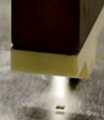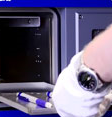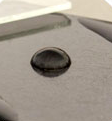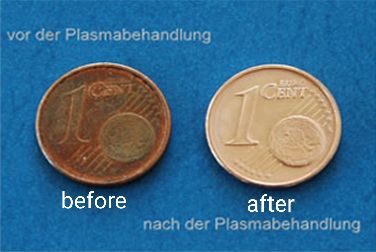Introduction to plasma surface treatment
Plasma, the fourth state of matter, is an ionized gaseous substance composed of atoms deprived of some electrons and positive and negative electrons generated after atoms are ionized. Its energy range is higher than that of gas, liquid, and solid matter. There are electrons, ions and neutral particles with a certain energy distribution. When they collide with the surface of the material, they will transfer their energy to the molecules and atoms on the surface of the material. A series of physical and chemical processes. Its function on the surface of the object can achieve ultra-clean cleaning of the object, surface activation, etching, finishing and plasma surface coating.

(1) Etching on the surface of the material
A large number of active particles in the plasma, such as a large number of ions, excited molecules, and free radicals, act on the surface of a solid sample to remove the original contamination The surface becomes rough, forming many tiny potholes, increasing the specific surface of the sample. Improve the wettability of solid surfaces.
(2) Activation bond energy, cross-linking effect
The particle energy in the plasma is 0-20eV, and most of the bond energy in the polymer is 0-10eV. Therefore, after the plasma acts on the solid surface, the original chemical bonds on the solid surface can be broken. These bonds of free radicals form a network-like cross-linked structure, which greatly activates the surface activity.
(3) Form new functional groups
Chemical action If reactive gas is introduced into the discharge gas, then complex chemical reactions will occur on the surface of the activated material, introducing new functional groups, such as hydrocarbon groups, amino groups, carboxyl groups, etc. These functional groups are all active groups, which can significantly improve the material. Surface activity.
Technology and Application of Plasma Surface Treatment
For the surface cleaning of plasma surface treatment technology, it can remove the release agent and additives on the surface, and the activation process can ensure the quality of the subsequent bonding process and coating process. For coating treatment, The surface properties of the composite can be further improved. Using this plasma technology, the surface pretreatment of materials can be efficiently performed according to specific process requirements.




surface cleaning surface activation surface etching surface coating
Plasma surface treatment technology can be applied to various industries, such as rubber and plastics industry, automotive electronics industry, defense industry, medical industry, aviation industry and so on.
Plasma surface treatment technology also has the following advantages:
1. Environmental protection technology: The plasma surface treatment process is a gas-solid coherent reaction, which does not consume water resources and does not need to add chemicals
2. High efficiency: the whole process can be completed in a short time
3. Low cost: the device is simple, easy to operate and maintain, a small amount of gas replaces the expensive cleaning liquid, and there is no waste liquid processing cost.
4. Processing is more refined: able to penetrate into the interior of micro-holes and depressions and complete the cleaning task
5. Wide applicability: plasma surface treatment technology can realize the treatment of most solid substances, so the application field is very wide
Changes in plasma surface treatment
The surface treated by plasma technology, whether it is plastic, metal or glass, can obtain an increase in surface energy. Through such a treatment process, the surface state of the product can fully meet the requirements of subsequent coating, bonding and other processes. Plasma surface treatment in the printing and packaging industry can greatly improve bonding strength, reduce costs, stable bonding quality, good product consistency, no dust, and clean environment.

How long does the plasma surface treatment fail?
Regarding the plasma treatment time, the cross-linking, chemical modification, and etching that occur on the surface of the polymer treated by the ionomer are mainly due to the fact that the plasma causes the bonds on the surface of the polymer to break and generate a large number of free radicals.
The experiment shows that with the extension of the plasma treatment time and the increase of the discharge power, the intensity of the generated free radicals increases. After reaching the maximum point, it enters a dynamic equilibrium; when the discharge pressure is at a certain value, the intensity of the free radicals appears at the maximum, that is, Under certain conditions, the low-temperature plasma has the deepest reaction to the polymer surface.
Plasma surface treatment may be due to the nature of the material itself, secondary pollution after treatment, and chemical reaction. The retention time of the surface energy after treatment is difficult to determine. After the plasma surface treatment reaches a higher surface, immediately proceed to the next process to avoid the impact of surface energy attenuation.
评论
发表评论